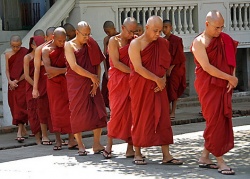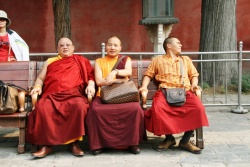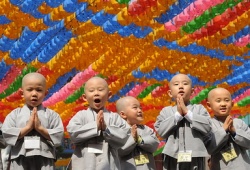Going for Refuge
- See also :
- See also :
The act of going for Refuge marks the point where one commits oneself to taking the Dhamma, or The Buddha's teaching, as the primary guide to one's Life. To understand why this commitment is called a "Refuge," it's helpful to look at the history of the custom.
In pre-Buddhist India, going for Refuge meant proclaiming one's allegiance to a patron — a powerful person or God — submitting to the patron's directives in hopes of receiving protection from danger in return. In the early years of The Buddha's teaching career, his new followers adopted this custom to express their allegiance to The Buddha, Dhamma, and Sangha, but in the Buddhist context this custom took on a new meaning.
Buddhism is not a theistic religion — The Buddha is not a God — and so a person Taking Refuge in the Buddhist sense is not asking for The Buddha personally to intervene to provide protection. Still, one of The Buddha's central teachings is that human Life is fraught with dangers — from Greed, Anger, and Delusion — and so the concept of Refuge is central to the path of practice, in that the practice is aimed at gaining release from those dangers. Because the mind is the source both of the dangers and of release, there is a need for two levels of Refuge: external refuges, which provide models and guidelines so that we can identify which qualities in the mind lead to danger and which to release; and internal refuges, i.e., the qualities leading to release that we develop in our own mind in imitation of our external models. The internal level is where true Refuge is found.
Although the tradition of going to Refuge is an ancient practice, it is still relevant for our own practice today, for we are faced with the same internal dangers that faced people in The Buddha's time. We still need the same protection as they. When a Buddhist takes Refuge, it is essentially an act of Taking Refuge in the Doctrine of Karma: It's an act of submission in that one is committed to living in line with the principle that actions based on skillful intentions lead to Happiness, while actions based on unskillful intentions lead to Suffering; it's an act of claiming protection in that, by following the teaching, one hopes to avoid the misfortunes that bad Karma engenders. To take Refuge in this way ultimately means to take Refuge in the quality of our own intentions, for that's where the essence of Karma lies.
The refuges in Buddhism — both on the internal and on the external levels — are The Buddha, Dhamma, and Sangha, also known as the Triple Gem. They are called gems both because they are valuable and because, in ancient times, gems were believed to have protective powers. The Triple Gem outdoes other gems in this respect because its protective powers can be put to the test and can lead further than those of any physical gem, all the way to absolute freedom from the uncertainties of the realm of aging, illness, and Death.
The Buddha, on the external level, refers to Siddhattha Gotama, the Indian prince who renounced his royal titles and went into the forest, meditating until he ultimately gained Awakening. To take Refuge in The Buddha means, not Taking Refuge in him as a person, but Taking Refuge in the fact of his Awakening: placing Trust in the belief that he did awaken to the Truth, that he did so by developing qualities that we too can develop, and that the truths to which he awoke provide the best perspective for the conduct of our Life.
The Dhamma, on the external level, refers to the path of practice The Buddha taught to this followers. This, in turn, is divided into three levels: the words of his teachings, the act of putting those teachings into practice, and the attainment of Awakening as the result of that practice. This three-way division of the word "Dhamma" acts as a map showing how to take the external refuges and make them internal: learning about the teachings, using them to develop the qualities that The Buddha himself used to attain Awakening, and then realizing the same release from danger that he found in the quality of Deathlessness that we can touch within.
The word Sangha, on the external level, has two senses: conventional and ideal. In its ideal sense, The Sangha consists of all people, lay or ordained, who have practiced the Dhamma to the point of gaining at least a glimpse of the Deathless. In a conventional sense, Sangha denotes the communities of ordained monks and nuns. The two meanings overlap but are not necessarily identical. Some members of the ideal Sangha are not ordained; some monks and nuns have yet to touch the Deathless. All those who take Refuge in The Buddha, Dhamma, and Sangha become members of The Buddha's four-fold assembly (parisa) of followers: monks, nuns, male lay devotees, and female lay devotees. Although there's a widespread belief that all Buddhist followers are members of The Sangha, this is not the case. Only those who are ordained are members of The Conventional Sangha; only those who have glimpsed the Deathless are members of the ideal Sangha. Nevertheless, any followers who don't belong to The Sangha in either sense of the word still count as genuine Buddhists in that they are members of The Buddha's parisa.
When Taking Refuge in the external Sangha, one takes Refuge in both senses of The Sangha, but the two senses provide different levels of Refuge. The Conventional Sangha has helped keep the teaching alive for more than 2,500 years. Without them, we would never have learned what The Buddha taught. However, not all members of The Conventional Sangha are reliable models of behavior. So when looking for guidance in the conduct of our lives, we must look to the living and recorded examples provided by the ideal Sangha. Without their example, we would not know (1) that Awakening is available to all, and not just to The Buddha; and (2) how Awakening expresses itself in real Life.
On the internal level, The Buddha, Dhamma, and Sangha are the skillful qualities we develop in our own minds in imitation of our external models. For instance, The Buddha was a person of Wisdom, purity, and Compassion. When we develop Wisdom, purity, and Compassion in our own minds, they Form our Refuge on an internal level. The Buddha tasted Awakening by developing conviction, persistence, Mindfulness, Concentration, and discernment. When we develop these same qualities to the point of attaining Awakening too, that Awakening is our ultimate Refuge. This is the point where the three aspects of the Triple Gem become one: beyond the reach of Greed, Anger, and Delusion, and thus totally secure.
Readings
'Indeed, the Blessed One [the Buddha] is worthy and rightly self-awakened, consummate in Knowledge and conduct, well-gone, an expert with regard to the cosmos, unexcelled as a trainer for those people fit to be tamed, the Teacher of divine and human beings, awakened, blessed.'
'The Dhamma is well-expounded by the Blessed One, to be seen here and now, timeless, inviting verification, pertinent, to be realized by the wise for themselves.'
'The Sangha of the Blessed One's disciples who have practiced well... who have practiced straight-forwardly... who have practiced methodically... who have practiced masterfully — in other words, the four types of noble disciples when taken as pairs, the eight when taken as individual types — they are The Sangha of the Blessed One's disciples: worthy of gifts, worthy of Hospitality, worthy of offerings, worthy of respect, the incomparable field of Merit for the World.'
— A X.92 Buddha
[The Buddha speaks:] I lived in refinement, utmost refinement, total refinement. My father even had Lotus ponds made in our palace: one where red-lotuses bloomed, one where white lotuses bloomed, one where blue lotuses bloomed, all for my sake. I used no sandalwood that was not from Varanasi. My turban was from Varanasi, as were my tunic, my lower garments, and my outer cloak. A white sunshade was held over me day and night to protect me from cold, heat, dust, dirt, and dew.
I had three palaces: one for the cold season, one for the hot season, one for the rainy season. During the four months of the rainy season I was entertained in the rainy-season palace by minstrels without a single man among them, and I did not once come down from the palace. Whereas the servants, workers, and retainers in other people's homes are fed meals of lentil soup and broken rice, in my father's home the servants, workers, and retainers were fed wheat, rice, and meat.
Even though I was endowed with such Fortune, such total refinement, the thought occurred to me: "When an untaught, run-of-the-mill person, himself subject to aging, not beyond aging, sees another who is aged, he is horrified, humiliated, and disgusted, oblivious to himself that he too is subject to aging, not beyond aging. If I — who am subject to aging, not beyond aging — were to be horrified, humiliated, and disgusted on seeing another person who is aged, that would not be fitting for me." As I noticed this, the [typical] young person's intoxication with youth entirely dropped away.
Even though I was endowed with such Fortune, such total refinement, the thought occurred to me: "When an untaught, run-of-the-mill person, himself subject to illness, not beyond illness, sees another who is ill, he is horrified, humiliated, and disgusted, oblivious to himself that he too is subject to illness, not beyond illness. And if I — who am subject to illness, not beyond illness — were to be horrified, humiliated, and disgusted on seeing another person who is ill, that would not be fitting for me." As I noticed this, the healthy person's intoxication with health entirely dropped away.
Even though I was endowed with such Fortune, such total refinement, the thought occurred to me: "When an untaught, run-of-the-mill person, himself subject to Death, not beyond Death, sees another who is dead, he is horrified, humiliated, and disgusted, oblivious to himself that he too is subject to Death, not beyond Death. And if I — who am subject to Death, not beyond Death — were to be horrified, humiliated, and disgusted on seeing another person who is dead, that would not be fitting for me." As I noticed this, the living person's intoxication with Life entirely dropped away.


